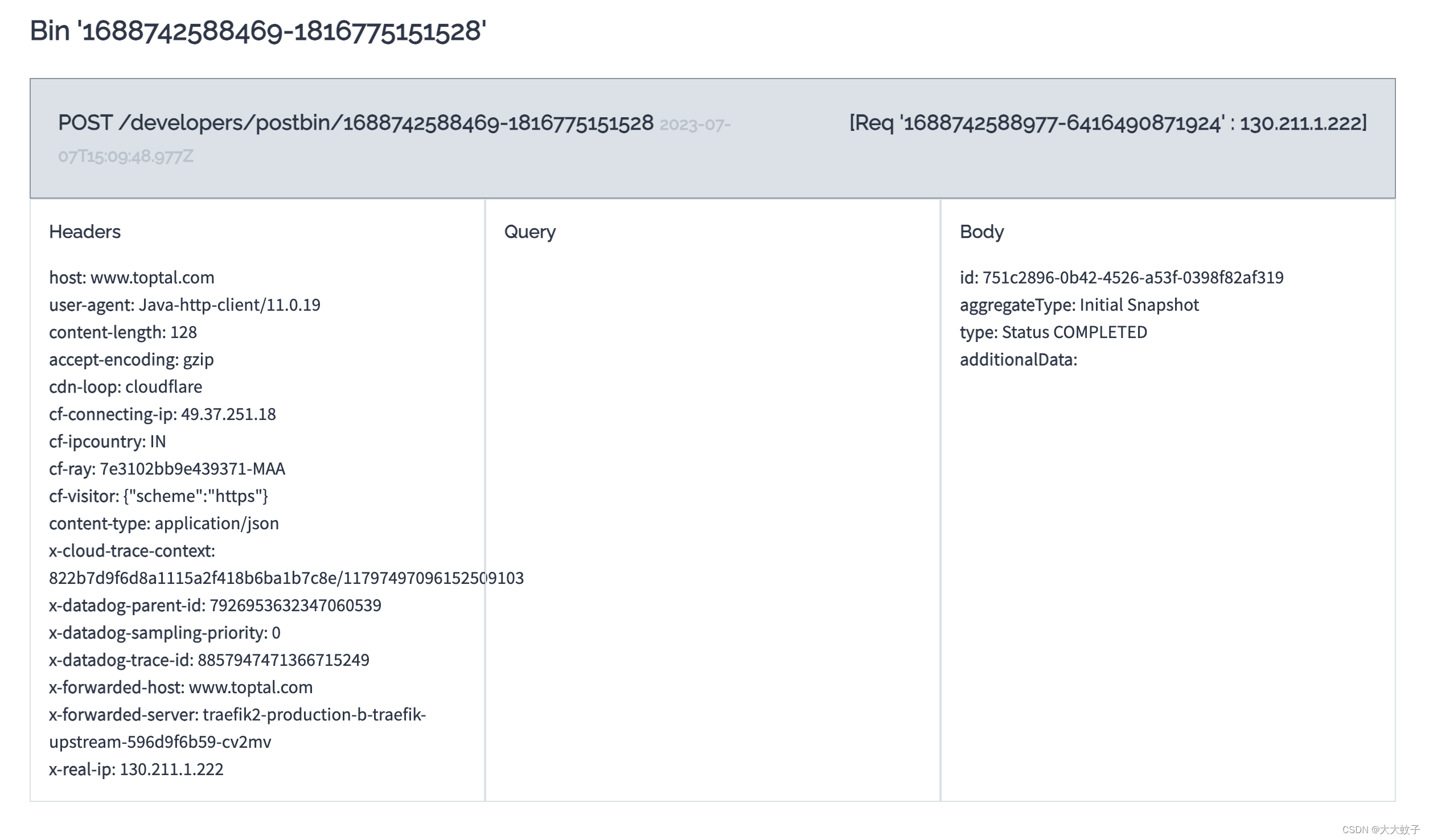原文地址: https://debezium.io/blog/2023/07/10/custom-http-signaling-notification/
欢迎关注留言,我是收集整理小能手,工具翻译,仅供参考,笔芯笔芯.
Debezium signaling and notifications - Part 2: Customisation
July 10, 2023 by Anisha Mohanty
debezium features notifications signaling custom channels
欢迎来到这个系列文章专门讨论信号和通知德贝齐姆!这篇文章作为本系列的第二部分,我们将在这里讨论如何自定义Debezns中的信号和通知通道。
Debezum2.3引入了信号和通知能力的新改进。您可以设置新的信号和通知通道,除了预先定义的信号和通知通道由DEBeZUS提供。这一功能使用户能够定制系统,以适应其独特的需求,并将其与现有的基础设施或第三方解决方案相结合。它能够通过精确捕捉和传递信号事件并通过首选渠道触发通知,对数据变化进行有效的监测和积极的响应。
本系列的第一篇文章, 代贝兹的信号和通知 ,概述德贝兹的信号和通知功能。它还讨论了可用的渠道及其在各种情况下的用例。
定制信号和通知通道
在Debezum中,可以定制信号和通知通道以适应特定的需求。例如,我们可以通过创建一个HTTP 信号和通知的通道。这个HTTP 通道接收来自HTTP端点的信号,并且可以在信号传递时将通知送回端点。
让我们来探索一个演示如何创建和利用HTTP 使用德贝兹波斯特连接器的信号和通知通道,A 模拟服务器 发出信号, 邮筒 通过http端点接收通知。
设置HTTP 信号通道:
在发生相关数据库更改时,配置德贝兹(Debezum)连接器以接收信号。
建立一个服务,利用HTTP 频道。该服务可以是数据库、第三方应用程序或任何其他可以发送HTTP请求的系统。在本例中,我们将使用模拟服务器将信号发送到Debezns。模拟服务器是一种可以用来模拟HTTP请求和响应的服务。
配置模拟服务器,使用适当的http方法(例如)通过http端点发送信号。,邮政)。
定制HTTP 通道设置,以定义http端点网址、身份验证、标题和任何所需的其他参数。
设置HTTP 通知渠道:
一旦信号被Debezum接收和处理,它就可以触发将通知张贴到http端点。在本例中,我们将使用HTTP 频道。邮政箱是一种服务,可以用来接收HTTP请求并查看请求详细信息。
定制HTTP 通知的通道设置,在邮件箱中创建一个资料库,并定义http端点URL、身份验证、标题和任何所需的附加参数。
使用适当的HTTP方法将通知事件转发到http端点即邮政资料箱(例如。,邮政)。通知有效载荷可以根据需要定制。
在博客帖子中,此示例的完整源代码在Debezum示例存储库中提供。 http-signal-notification 目录。
创建一个Java项目来构建HTTP 信号和通知渠道。运行以下命令,以使用MAVIN创建一个新的Java项目:
mvn archetype:generate
-DgroupId=io.debezium.examples
-DartifactId=http-signaling-notification
将下列从属关系添加到pom.xml 德贝佐姆版本的文件(2.3及后版本):
services:
mockServer:
image: mockserver/mockserver:latest
ports:
- 1080:1080
environment:
- MOCKSERVER_WATCH_INITIALIZATION_JSON=true
- MOCKSERVER_INITIALIZATION_JSON_PATH=/config/initializerJson.json
volumes:
- ./initializerJson.json:/config/initializerJson.json
环境变量MOCKSERVER_WATCH_INITIALIZATION_JSON 和MOCKSERVER_INITIALIZATION_JSON_PATH 设置为使模拟服务器监视初始化JSON文件中的更改并指定其路径。…initializerJson.json 文件,其中包含的http请求和响应信息的信号,是安装到模拟服务器容器。
…initializerJson.json 文件定义了对路径的模拟http请求/api/signal 使用查询字符串参数code=10969 .当模拟服务器收到此请求时,它将与一个含有id ,type ,以及data .响应的状态代码为200,表示成功响应。定义:initializerJson.json 文件如下:
[
{
“httpRequest” : {
“method” : “GET”,
“path” : “/api/signal”,
“queryStringParameters” : {
“code” : [“10969”]
}
},
“httpResponse” : {
“body”: “{“id”:“924e3ff8-2245-43ca-ba77-2af9af02fa07”,“type”:“log”,“data”:{“message”: “Signal message received from http endpoint.”}}”,
“statusCode”: 200
}
}
]
id一个用来识别信号实例的任意唯一字符串。
type :发送的信号类型。在这个例子中,类型是log 它要求连接器向连接器的日志文件添加一个条目。在处理信号之后,连接器在日志中打印指定的消息。
data :传递到信号事件的jon格式参数。在这个例子中,message 参数传递到信号事件。
创造HTTP 通过实施SignalChannelReader 接口如下:
public class HttpSignalChannel implements SignalChannelReader {
private static final Logger LOGGER = LoggerFactory.getLogger(HttpSignalChannel.class);
public static final String CHANNEL_NAME = "http";
private static final List<SignalRecord> SIGNALS = new ArrayList<>();
public CommonConnectorConfig connectorConfig;@Override
public String name() { return CHANNEL_NAME;
}@Override
public void init(CommonConnectorConfig connectorConfig) { this.connectorConfig = connectorConfig;
}@Override
public List<SignalRecord> read() { try {String requestUrl = "http://mockServer:1080/api/signal?code=10969";// send http request to the mock serverHttpClient httpClient = HttpClient.newHttpClient();HttpRequest request = HttpRequest.newBuilder().uri(URI.create(requestUrl)).GET().header("Content-Type", "application/json").build();// read the responseHttpResponse<String> response = httpClient.send(request, HttpResponse.BodyHandlers.ofString());if (response.statusCode() == 200) {ObjectMapper mapper = new ObjectMapper();String responseBody = response.body();// parse the response bodyJsonNode signalJson = mapper.readTree(responseBody);Map<String, Object> additionalData = signalJson.has("additionalData") ? mapper.convertValue(signalJson.get("additionalData"), new TypeReference<>() {}) : new HashMap<>();String id = signalJson.get("id").asText();String type = signalJson.get("type").asText();String data = signalJson.get("data").toString();SignalRecord signal = new SignalRecord(id, type, data, additionalData);LOGGER.info("Recorded signal event '{}' ", signal);// process the signalSIGNALS.add(signal);} else {LOGGER.warn("Error while reading signaling events from endpoint: {}", response.statusCode());}} catch (IOException | InterruptedException e) {LOGGER.warn("Exception while preparing to process the signal '{}' from the endpoint", e.getMessage());e.printStackTrace();}return SIGNALS;}@Override
public void close() { SIGNALS.clear();
}
}
…name() 方法返回信号通道的名称。若要启用德贝兹使用通道,请指定名称http 在连接器的signal.enabled.channels 财产。
…init() 方法可以用来初始化HTTP通道需要的特定配置、变量或连接。
…read() 方法从http端点读取信号并返回一个列表SignalRecord 将由德贝兹连接器处理的对象。
…close() 方法关闭所有分配的资源。
通过实现NotificationChannel 接口如下:
public class HttpNotificationChannel implements NotificationChannel {
private static final Logger LOGGER = LoggerFactory.getLogger(HttpNotificationChannel.class);
public static final String CHANNEL_NAME = "http";
private static final String NOTIFICATION_PREFIX = "[HTTP NOTIFICATION SERVICE]";@Override
public String name() { return CHANNEL_NAME;
}@Override
public void init(CommonConnectorConfig config) { // custom configuration
}@Override
public void send(Notification notification) { LOGGER.info(String.format("%s Sending notification to http channel", NOTIFICATION_PREFIX));String binId = createBin();sendNotification(binId, notification);
}private static String createBin() {// Create a bin on the servertry {HttpRequest request = HttpRequest.newBuilder().uri(new URI("https://www.toptal.com/developers/postbin/api/bin")).POST(HttpRequest.BodyPublishers.ofString(" ")).build();HttpClient httpClient = HttpClient.newHttpClient();HttpResponse<String> response = httpClient.send(request, HttpResponse.BodyHandlers.ofString());if (response.statusCode() == HTTP_CREATED) {String binId = response.body().replaceAll(".*\"binId\":\"([^\"]+)\".*", "$1");LOGGER.info("Bin created: " + response.body());return binId;}} catch (URISyntaxException | InterruptedException | IOException e) {throw new RuntimeException(e);}return null;
}private static void sendNotification (String binId, Notification notification) {// Get notification from the bintry {ObjectMapper mapper = new ObjectMapper();String notificationString = mapper.writeValueAsString(notification);HttpRequest request = HttpRequest.newBuilder().uri(new URI("https://www.toptal.com/developers/postbin/" + binId)).header("Content-Type", "application/json").POST(HttpRequest.BodyPublishers.ofString(notificationString)).build();HttpClient httpClient = HttpClient.newHttpClient();HttpResponse<String> response = httpClient.send(request, HttpResponse.BodyHandlers.ofString());if (response.statusCode() == HTTP_OK) {LOGGER.info("Notification received : " + response.body());}} catch (URISyntaxException | InterruptedException | IOException e) {throw new RuntimeException(e);}
}@Override
public void close() {
}
}
…name() 方法返回通知通道的名称。若要启用德贝兹使用通道,请指定http 在连接器的notification.enabled.channels 财产。
…init() 方法可以用来初始化通道所需的特定配置、变量或连接。
…send() 方法将通知发送到通道。该通知载有SignalRecord 由德贝兹接头处理的对象。
…close() 方法关闭所有分配的资源。
宣布HTTP 的信号和通知渠道META-INF/services 目录下io.debezium.pipeline.signal.SignalChannelReader 和io.debezium.pipeline.notification.channels.NotificationChannel 文件。
将Java项目编译并导出为JAR文件。这可以使用MAVIN或您首选的构建工具来完成。将JAR文件复制到包含您想要使用的Debezum连接器的JAR文件的目录中。例如,如果您想使用与Debezum后角连接器的自定义信号和通知通道,请将JAR文件复制到/kafka/connect/debezium-connector-postgres 目录。
这个例子提供了一个码头组合文件,其中定义了必要的服务,其中包括模拟服务器、动物园管理员、卡夫卡连接和波斯特格雷斯数据库。
要启动服务,请运行以下命令:
export DEBEZIUM_VERSION=2.3
docker-compose up -d
在确保服务的运行和运行之后,以及之后的下一步是注册连接器。这包括创建一个连接器配置文件。我们创建一个名为register-postgres.json 拥有下列属性:
{
“name”: “inventory-connector”,
“config”: {
“connector.class”: “io.debezium.connector.postgresql.PostgresConnector”,
“tasks.max”: 1,
“database.hostname”: “postgres”,
“database.port”: 5432,
“database.user”: “postgres”,
“database.password”: “postgres”,
“database.dbname” : “postgres”,
“topic.prefix”: “dbserver1”,
“schema.include.list”: “inventory”,
“signal.enabled.channels”: “http”,
“notification.enabled.channels”: “http”
}
}
…signal.enabled.channels 属性指定连接器要使用的信号通道。在这种情况下,连接器使用http 信号通道。
…notification.enabled.channels 属性指定连接器要使用的通知通道。在这种情况下,连接器使用http 通知频道。
现在我们已经准备好了连接器配置文件,我们可以通过执行以下命令来注册卡夫卡连接器:
curl -i -X POST -H “Accept:application/json”
-H “Content-Type:application/json” http://localhost:8083/connectors/
-d @register-postgres.json
一旦连接器成功注册,您可以查看连接器日志以观察信号事件。日志提供了对连接器处理和进展的深入了解,包括任何与信号相关的信息。你会遇到类似以下的日志信息:
Recorded signal event ‘SignalRecord{id=‘924e3ff8-2245-43ca-ba77-2af9af02fa07’, type=‘log’, data=’{“message”:“Signal message received from http endpoint.”}’, additionalData={}}’ [io.debezium.examples.signal.HttpSignalChannel]
此外,您可能会注意到与发送到邮件箱的通知事件有关的日志消息。例如:
[HTTP NOTIFICATION SERVICE] Sending notification to http channel [io.debezium.examples.notification.HttpNotificationChannel]
Bin created: {“binId”:“1688742588469-1816775151528”,“now”:1688742588470,“expires”:1688744388470} [io.debezium.examples.notification.HttpNotificationChannel]
它提供关于通知事件的信息,例如创建带有唯一标识符(BINID)的垃圾箱和其他相关细节。若欲从邮政局检索通知事件,请取binId 从日志消息,并使用它来请求来自邮政信息库的相应通知事件。要查看通知事件,您可以使用以下网址访问邮政资料库:https://www.toptal.com/developers/postbin/b/:binId .替换:binId 从连接器日志中获得的实际二进制的URL中。
发送到邮政局的通知事件如下:
图片来自官网原文

资料夹后预览
结论
在本教程中,我们探讨了如何为德贝齐亚连接器创建自定义信号和通知通道。我们创建了一个自定义信号通道,它接收来自http端点的信号事件。我们还创建了一个自定义通知通道,该通道将通知事件发送到http端点。
Debezum的全面的信号和通知系统提供了与第三方解决方案的无缝集成,使用户能够随时了解Debezum连接器的状态和进展。该系统的可扩展性使用户能够定制信号和通知通道,以适应其定制需求。
请继续关注本系列的第3部分,我们将在这里探索关于jmx信号和通知的内容。与此同时,您可以查看Debezum文档,了解更多有关信号和通知通道的信息。
如果您有任何问题或反馈,请随时与我们联系。 邮寄清单 或 #通信秘书长 关于郁金香聊天的频道。我们很乐意听到你的消息!



















)